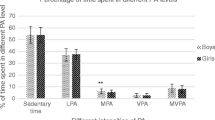Abstract
Background
Physical inactivity and sedentary lifestyles are known to predispose to overweight and obesity. These lifestyles are also known to track from childhood into adulthood with consequent cardiovascular and metabolic problems. This study aimed to describe the frequency of physical activity and the relationship between physical activity and body mass index of urban Nigerian school children and adolescents.
Methods
Children from seven schools in Abeokuta, southwest Nigeria were selected using a multi-staged random sampling technique.
Results
Of 570 children, 411 (72.1%) were involved in moderate to vigorous physical activities. Involvement in physical activity was higher in older children (P<0.001), males (P<0.001), and children of mothers with a higher educational level (P=0.03). Eleven (1.9%) children were overweight or obese whereas 163 (28.6%) were underweight. There were more children with underweight than overweight among the subject population with a high level of physical activity (35.6% vs. 4.4%, P=0.499).
Conclusions
A large proportion of the children in urban Nigeria participate in physical activity. The prevalence of overweight and obesity is low but undernutrition is a major nutritional problem among these children.
Similar content being viewed by others
References
World Health Organization. Obesity: preventing and managing the global epidemic. Report of a WHO consultation. World Health Organ Tech Rep Ser 2000;894:i–xii,1–253.
van der Sande MA, Ceesay SM, Milligan PJ, Nyan OA, Banya WA, Prentice A, et al. Obesity and undernutrition and cardiovascular risk factors in rural and urban Gambian communities. Am J Public Health 2001;91:1641–1644.
Popkin BM, Richards MK, Montiero CA. Stunted is associated with overweight in four nations that are undergoing the nutrition transition. J Nutr 1996;126:3009–3016.
Deckelbaum RJ, Williams CL. Childhood obesity: the health issue. Obes Res 2001;9:239S–243S.
de Onis M, Blössner M. Prevalence and trends of overweight among preschool children in developing countries. Am J Clin Nutr 2000;72:1032–1039.
Ben-Bassey UP, Oduwole AO, Ogundipe OO. Prevalence of overweight and obesity in Eti-Osa LGA, Lagos, Nigeria. Obes Rev 2007;8:475–479.
Collins AE, Pakiz B, Rock CL. Factors associated with obesity in Indonesian adolescents. Int J Pediatr Obes 2008;3:58–64.
Mahfouz AA, Abdelmoneim I, Khan MY, Daffalla AA, Diab MM, Al-Gelban KS, et al. Obesity and related behaviors among adolescent school boys in Abha city, southwestern Saudi Arabia. J Trop Pediatr 2008;54:120–124.
Planinsec J, Matejek C. Differences in physical activity between non-overweight, overweight and obese children. Coll Antropol 2004;28:747–754.
Westerterp KR, Goran MI. Relationship between physical activity related energy expenditure and body composition: a gender difference. Int J Obes Relat Metab Disord 1997;21:184–188.
Kruger R, Kruger HS, Maclntyre UE. The determinants of overweight and obesity among 10- to 15- year-old schoolchildren in the North West Province, South Africa—the THUSA BANA (Transition and Health during Urbanisation of South Africans; BANA, children) study. Public Health Nutr 2006;9:351–358.
Ntandou G, Delisle H, Agueh V, Fayomi B. Physical activity and socioeconomic status explain rural-urban differences in obesity: a cross-sectional study in Benin (West Africa). Ecol Food Nutr 2008;47:313–337.
Senbanjo IO, Adejuyigbe EA. Prevalence of overweight and obesity among Nigerian preschool children. Nutr Health 2007;18:391–399.
Oyedeji GA. Socioeconomic and cultural background of hospitalized children in Ilesa. Nig J Paediatr 1985;12:111–117.
Sirard JR, Pate RR. Physical activity and assessment in children and adolescents. Sports Med 2001;31:439–454.
Welk GJ, Corbin CB, Dale D. Measurement issues in the assessment of physical activity in children. Res Q Exerc Sport 2000;71:S59–73.
World Health Organization. Physical status: the use and interpretation of anthropometry. Report of a WHO Expert Committee. World Health Organ Tech Rep Ser 1995;854:1–452.
Amorim PR, de Faria RC, Byrne NM, Hills AP. Physical activity and nutritional status of children of low socioeconomic status. Two interrelated problems: undernutrition and overweight. Asia Pac J Clin Nutr 2006;15:217–223.
Kann L, Kinchen SA, Williams BI, Ross JG, Lowry R, Grunbaum JA, et al. Youth risk behavior surveillance—United States, 1999. MMWR Surveill Summ 2000;49:1–32.
Shephard RJ. Curricular physical activity and academic performance. Pediatr Exerc Sci 1997;9:113–126.
Symons CW, Cinelli B, James TC, Groff P. Bridging student health risks and academic achievement through comprehensive school health programs. J Sch Health 1997;67:220–227.
Al-Nakeeb Y, Duncan MJ, Lyons M, Woodfield L. Body fatness and physical activity levels of young children. Ann Hum Biol 2007;34:1–12.
Caspersen CJ, Pereira MA, Curran KM. Changes in physical activity patterns in the United States, by sex and cross-sectional age. Med Sci Sports Exerc 2000;32:1601–1609.
Trost SG, Pate RR, Sallis JF, Freedson PS, Taylor WC, Dowda M, et al. Age and gender differences in objectively measured physical activity in youth. Med Sci Sports Exerc 2002;34:350–355.
Sherar LB, Esliger DW, Baxter-Jones AD, Tremblay MS. Age and gender differences in youth physical activity: does physical maturity matter? Med Sci Sports Exerc 2007;39:830–835.
Ortega FB, Ruiz JR, Sjöström M. Physical activity, overweight and central adiposity in Swedish children and adolescents: the European Youth Heart Study. Int J Behav Nutr Phys Act 2007;4:61.
Trost SG, Rosenkran RR, Dzewaltowski D. Physical activity levels among children attending after-school programs. Med Sci Sports Exerc 2008;40:622–629.
Borraccino A, Lemma P, Iannotti RJ, Zambon A, Dalmasso P, Lazzeri G, et al. Socioeconomic effects on meeting physical activity guidelines: comparisons among 32 countries. Med Sci Sports Exerc 2009;41:749–756.
Thompson AM, Campagna PD, Rehman LA, Murphy RJ, Rasmussen RL, Ness GW, et al. Physical activity and body mass index in grade 3, 7, and 11 Nova Scotia students. Med Sci Sports Exerc 2005;37:1902–1908.
Author information
Authors and Affiliations
Corresponding author
Rights and permissions
About this article
Cite this article
Senbanjo, I.O., Oshikoya, K.A. Physical activity and body mass index of school children and adolescents in Abeokuta, Southwest Nigeria. World J Pediatr 6, 217–222 (2010). https://doi.org/10.1007/s12519-010-0209-9
Received:
Accepted:
Published:
Issue Date:
DOI: https://doi.org/10.1007/s12519-010-0209-9




